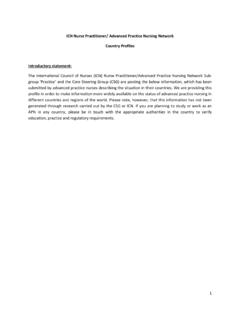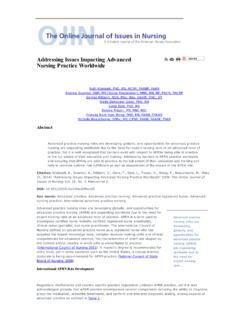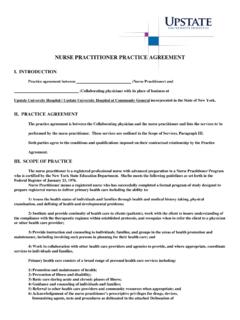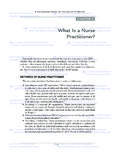Transcription of The Nurse Practitioner
1 The Nurse PractitionerA Strategy for Healthcare System ImprovementInvestment in the NP role will lead to health system improvements through better access to high quality cost-effective care. For more information: Nurse Practitioners (NPs) can be better utilized to improve healthcare system efficiency, access and quality. NPs contribute to better care for individuals, better health for populations and lower healthcare NPs are registered nurses who are licensed in all provinces and territories to autonomously diagnose, prescribe medications, order and interpret diagnostic tests, and perform specific clinical procedures. NPs focus on health promotion, disease prevention and acute and chronic illness management. NPs provide services to patients across the lifespan, families, groups and communities. NPs have existed in Canada for over 40 years. They work collaboratively within interprofessional teams in primary healthcare, long-term care and acute care settings.
2 Key MessagesBetter Care for Individuals NPs increase access to high quality care in primary healthcare clinics, reduce wait times in emergency departments and increase timeliness of care in nursing homes. In the community, NPs promote wellness by providing preventive care, treating minor acute illness, and managing chronic diseases. In hospitals, NPs enhance continuity of care for seriously ill and complex care patients. NPs coordinate patient treatment and initiate appropriate and timely consultation or referral when the problem exceeds their scope of practice or expertise. Physicians and NPs working together improve continuity of care, interprofessional team planning, hospital discharge processes and post-discharge follow-up. Patients consistently report high levels of satisfaction with NP care. Better Health for Populations The presence of NPs in a variety of healthcare service delivery models is associated with high-quality disease management for chronic but stable conditions like diabetes or high blood pressure and improved patient outcomes.
3 NPs increase access to primary healthcare for vulnerable isolated groups, people living in rural and remote regions, and Aboriginal Peoples. NPs in acute care improve the health outcomes of high risk patient populations in units such as neonatology, cardiology, neurosurgery, and intensive care. Lower Costs In the community, NPs reduce costs in the care of general practice patients and specific patient populations such as those with diabetes, eczema, and those who live in rural areas. In hospitals, NPs improve patient readiness for discharge which leads to shorter length of stay and fewer re-admissions. In long-term care, NPs provide timely assessment, diagnosis and treatment for acute and episodic conditions and injuries which reduces avoidable transfers of residents to the emergency Issue;YfY\aYf ;]flj] ^gj9\nYf[]\ HjY[la[] Fmjkaf_J] k]Yj [`The Nurse PractitionerAllen, , Himmelfarb, , Szanton, , Bone, L., Hill, , Levine, (2011).
4 COACH trial: A randomized controlled trial of Nurse Practitioner /community health worker cardio-vascular disease risk reduction in urban com-munity health centers: rationale and design. Contemporary Clinical Trials, 32(3) , D. & DiCenso, A. (2004). A framework for the introduction and evalua-tion of advanced practice nursing roles. Jour-nal of Advanced Nursing, 48(5): B. (2009). Designing innova-tive cancer services and APN roles, Toolkit. Institutes for Health Information. (2011). Seniors and the health care system: What is the impact of multiple chronic condi-tions? Nurses Association. (2009). Posi-tion statement: The Nurse Practitioner . Ot-tawa, ON: Canadian Nurses Association. Nurse Practitioner Initiative. (2006). Implementation and Evaluation Tool-kit for Nurse Practitioners in Canada. , , Shapiro, M., Hays, , Afifi, A., Vazirani, S.
5 , Ward, , Ettner, (2006).The effect of a multidisciplinary hospitalist/physician and advanced practice Nurse col-laboration on hospital costs. Journal of Nurs-ing Administration, 36(2): , M-L., Lafortune, G., (2010). Nurses in advanced roles: A description and evaluation of experiences in 12 developed countries. OECD Health Working Paper No. 54. ,374 6,en_ 26 49_ 33929_ 2380 4 41_1_1_1_1, , A., Bourgeault, I., Abelson, J., Mar-tin Misener, R., Kaasalainen, S., Carter, N., Harbman, P., Donald, F., Bryant-Lukosius, D., Kilpatrick, K., (2010). Utilization of Nurse prac-titioners to increase patient access to prima-ry healthcare in Canada: Thinking outside the box. Canadian Journal of Nursing Leadership, 23(special issue): 239-259. Dierick-van Daele, , Metsemakers, , Derckx, , Spreeuwenberg, C., Vrijhoef, (2009). Nurse practitioners substituting for general practitioners: Randomized con-trolled trial.
6 Journal of Advanced Nursing, 65(2): Daele, , Steuten, , Metse-makers, , Derckx, , Spreeuwenberg, C., Vrijhoef, (2010). Economic evaluation of Nurse practitioners versus GPs in treating common conditions. British Journal of Gen-eral Practice, 60(570): , F., Bryant-Lukosius, D., Martin Misen-er, R., Kaasalainen, S., Kilpatrick, K., Carter, N., Harbman, P., Bourgeault, I., DiCenso, A. (2010). Clinical Nurse specialists and Nurse practitioners: Title confusion and lack of role clarity. Canadian Journal of Nursing Leader-ship, 23(special issue): 189-210. Donald, F., Martin Misener, R., Bryant-Luko-sius, D., Kilpatrick, K., Kaasalainen, S., Carter, N., Harbman, P., Bourgeault, I., DiCenso, A. (2010). The primary heathcare Nurse prac-titioner role in Canada. Canadian Journal of Nursing Leadership, 23(special issue): , J., Adler, , Pelletier, C., Mur-ray, D., Tepper, J.
7 (2009). The impact on patient flow after the integration of Nurse practitioners and physician assistants in 6 Ontario emergency departments. Canadian Journal of Emergency Medicine, 11(5), 455-461. Retrieved from , , Kotlerman, J., Afifi, A., Vazirani, S., Hays, , Shapiro, M., Cowan, M. (2006). An alternative approach to reducing the costs of patient care? A controlled trial of the multi-disciplinary doctor- Nurse Practitioner (MDNP) model. Medical Decision Making, 26(1): , K., Cook, B., Falcone, ,Jr, Rick-ets, C., Schweer, L., Brown, , Garcia, (2006). Pediatric trauma Nurse practitioners provide excellent care with superior patient satisfaction for injured children. Journal of Pediatric Surgery, 41(1): (2009). Canadians very com-fortable with expanded role for Nurse practi-tioners. Press release, August 13, 2009. Ot-tawa, ON. , S., Anderson, E., Salisbury, C.
8 , (2002). Systematic review of whether Nurse practitioners working in primary care can pro-vide equivalent care to doctors. British Medi-cal Journal, 324(7341): , S. Kleefstra, N., van Hateren, K., Kooy, A., Groenier, K., Ten Vergert, E., Mey-boom-de Jong, B., Bilo, H. (2009). Diabetes specialist Nurse as main care provider for patients with type 2 diabetes. Netherlands Journal of Medicine, 67(7): , D., Sidani, S., Porter, H., O Brien-Pallas, L., Simpson, B., McGillis Hall, L., Graydon, J., DiCenso, A., Redelmeir, D., & Nagel, L. (2000). Organizational factors influencing Nurse prac-titioners role implementation in acute care settings. Canadian Journal of Nursing Lead-ership, 13 (3): , S., Martin-Misener, R., Kilpat-rick, K., Harbman, P., Bryant-Lukosius, D., Donald, F,. Carter, N., DiCenso, A. (2010). A historical overview of the development of advanced practice nursing roles in Canada.
9 Canadian Journal of Nursing Leadership, 23(special issue): , K. (2010). Perceptions of team ef-fectiveness following the introduction of a cardiology acute care Nurse Practitioner role. Doctoral dissertation, McGill University, 238 pages. Kilpatrick, K., Harbman, P., Carter, N., Martin Misener, R., Bryant-Lukosius, D., Donald, F., Kaasalainen, S., Bourgeault, I., DiCenso, A., (2010). The acute care Nurse Practitioner role in Canada. Canadian Journal of Nursing Lead-ership, 23(special issue): , K., Lavoie-Tremblay, M., Ritchie, , & Lamothe, L. (2011). Advanced practice nursing, health care teams and perceptions of team effectiveness. The Health Care Man-ager, 30(3): , K., Lavoie-Tremblay, M., Ritchie, , Lamothe, L., Doran, D., & Rochefort, C. (in press). How are acute care Nurse practitio-ners enacting their roles in healthcare teams? A descriptive multiple-case study. Interna-tional Journal of Nursing Studies.
10 Lau, A., Tse, Y. (2012). NPSTAT: A novel Nurse Practitioner acute care model in the community for Canada s current and future aging population. Health Council of Canada. Retrieved from , R., Downe-Wamboldt, B., Cain, E., Girouard, M. (2009). Cost effective-ness and outcomes of a Nurse Practitioner paramedic family physician model of care: The Long and Brier Islands Study. Primary Health Care Research & Development, 10(1): , R., Bryant-Lukosius, D., Harbman, P., Donald, F., Kaasalainen, S., Carter, N., Kilpatrick, K., DiCenso, A. (2010). Education of advanced practice nurses in Canada. Canadian Journal of Nursing Leader-ship, 23(special issue): , R., Crawford, T., DiCenso, A., Akhtar-Danesh, N., Donald, F., Bryant-Lu-kosius, D., & Kaasalainen, S. (2010). A survey of the practice patterns of Nurse practitioners in primary health care in Nova Scotia.














